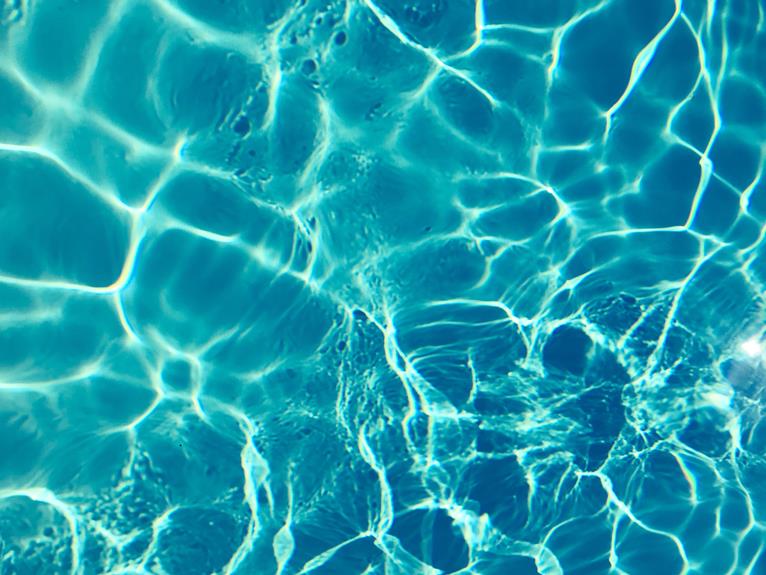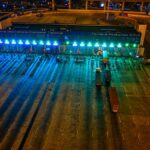Are you tired of the high monthly electrical costs that come with owning a swimming pool? Well, fear not! We’re here to uncover the secrets to managing your pool’s energy consumption effectively. From location and weather to pump type and efficiency, we’ll explore all the factors that impact your pool’s electrical costs. By the end of this article, you’ll have the knowledge and practical tips you need to reduce your monthly expenses. So, let’s dive in and save some money!
Key Takeaways
- The location of the swimming pool can have a significant impact on monthly electrical costs due to varying electricity rates and the climate.
- The type and efficiency of the pump used for the swimming pool can greatly affect electricity usage, with variable speed pumps being the most energy-efficient option.
- The size of the pool also plays a role in monthly electrical costs, as larger pools require more electricity for heating and maintenance.
- Implementing energy-saving measures such as reducing pump and heater usage and using a pool cover can help decrease electricity consumption and lower monthly costs.
Factors Affecting Monthly Electrical Costs for a Swimming Pool
Your monthly electrical costs for running a swimming pool can be influenced by various factors such as location, weather, pump type and efficiency, pool size, and pump running time. These factors play a crucial role in determining your monthly pool operational costs and pool electrical consumption. Firstly, the location of your pool affects your electricity rates, which can impact your monthly bills. Additionally, colder climates may result in higher pool heater costs. Secondly, the type and efficiency of your pump significantly affect your energy costs.
Energy-efficient pumps, such as Energy Star-rated variable speed or dual speed pumps, can help reduce pool energy costs. Thirdly, pool size plays a role in electrical consumption, as larger pools require more electricity for heating and maintenance. Lastly, reducing pump running time and employing energy-saving measures like using a pool cover and turning on the heater only when needed can help minimize pool energy costs.
Location-related Factors
Electricity rates in your region can impact the amount you pay for operating your pool on a monthly basis. It’s important to consider the location-related factors that can affect your pool electricity bill. Colder climates may result in higher pool heater costs, so if you live in an area with colder weather, you’ll need to account for that in your monthly expenses. Additionally, electricity rates vary by region, so it’s essential to know how much you’ll be charged per kilowatt-hour. To give you an idea of the potential impact, here is a table showcasing the average electricity rates in different regions:
| Region | Average Electricity Rate (per kWh) |
|---|---|
| East Coast | $0.12 |
| West Coast | $0.15 |
| Midwest | $0.10 |
Electricity Rates by Region
In analyzing the factors that influence monthly electrical costs for a swimming pool, one key consideration is the electricity rates that vary by region. These regional rate variations have a direct impact on your monthly bills, as they determine the cost of the electricity you consume. By comparing the cost differences between different regions, you can make informed decisions on how to manage and budget for your pool’s electrical expenses.
Regional Rate Variations
Rates for electricity can vary by region, which can impact the amount you pay for monthly pool operation. Regional rate variations play a significant role in determining your swimming pool electrical expenses. Higher electricity rates in certain areas can increase your pool heater electricity cost and overall monthly expenses. It is essential to consider these regional rate variations when budgeting for your pool’s electrical expenses. To get a better understanding of the potential impact, research the electricity rates in your specific region and factor them into your calculations. By being aware of these variations, you can make informed decisions about energy-saving measures and pool maintenance, ultimately reducing your swimming pool’s electrical expenses.
Impact on Monthly Bills
To better understand how much you’ll be paying each month, consider the impact that regional rate variations can have on your overall expenses. The cost of electricity can vary significantly depending on where you live. This means that the amount you spend on powering your swimming pool may differ based on your location. Additionally, factors such as weather, pump type, pool size, and pump running time can also affect your monthly electrical costs. For instance, colder climates may result in higher pool heater costs, while more efficient pumps can reduce electricity usage. Consider using energy-saving measures like turning on the pool heater only when necessary and using a pool cover to reduce the workload on the pump. Understanding these factors will help you make informed decisions to optimize pool lighting power consumption and improve pool electrical efficiency. With this knowledge, you can now proceed to compare cost differences and choose the most cost-effective options for running your swimming pool.
Comparing Cost Differences
When comparing cost differences, you can consider factors such as regional rate variations, weather, pump type, pool size, and pump running time to make informed decisions and choose the most cost-effective options for your pool. To further understand these factors, let’s take a look at the table below:
| Factors to Consider | Impact on Monthly Costs |
|---|---|
| Regional Rate Variations | Varies based on location |
| Weather | Colder climates may result in higher pool heater costs |
| Pump Type | Efficiency and power usage vary |
| Pool Size | Larger pools require more electricity for heating and maintenance |
| Pump Running Time | Duration of pump operation affects electricity consumption |
Impact of Weather on Pool Heater Costs
In colder climates, the weather has a direct impact on the costs of heating your pool. The colder the temperature, the more energy your pool heater will need to maintain the desired temperature. This can result in higher monthly bills for pool heating expenses.
Cold Climate, Higher Costs
Living in a colder climate can result in higher pool heater costs due to the increased need for heating. The colder the climate, the more energy and time it takes to warm the pool water to a comfortable temperature. Here are four reasons why colder climates lead to higher pool heater costs:
- Longer heating season: In colder climates, the pool heating season is longer, requiring more energy to maintain a warm pool throughout the year.
- Greater temperature difference: Colder climates have a larger temperature difference between the desired pool temperature and the ambient temperature, requiring more energy to heat the pool water.
- Increased heat loss: Cold weather causes more heat loss from the pool, leading to higher energy consumption to compensate for the lost heat.
- Insufficient solar heating: In colder climates, solar heating may not be sufficient to meet the pool’s heating needs, resulting in higher reliance on electric or gas pool heaters.
Therefore, it is important to consider these factors when budgeting for pool heater costs in colder climates.
Weather and Heating Expenses
To reduce your heating expenses, consider the impact of weather on your pool’s energy consumption. Cold weather can significantly increase your pool heater costs. In colder climates, you may need to run your pool heater for longer periods of time to maintain a comfortable water temperature. This extended usage can lead to higher energy consumption and ultimately higher energy bills. It’s important to be mindful of the weather conditions and adjust your pool heater accordingly. By monitoring the weather forecast and adjusting your heater usage accordingly, you can effectively manage your heating expenses and potentially save on your energy bills. Now let’s explore the impact of weather and heating expenses on your overall energy bills.
Impact on Energy Bills
You can save money on your energy bills by considering the impact of weather and heating expenses. Weather plays a significant role in determining the amount of electricity your pool requires to maintain a comfortable temperature. In colder climates, you may find yourself using the pool heater more frequently, resulting in higher heating costs. Additionally, the size of your pool also affects your energy consumption. Larger pools require more electricity to heat compared to smaller pools. To further reduce your energy bills, consider implementing energy-saving measures. Running the pool pump and heater only when necessary can significantly decrease electricity consumption. Using a pool cover can also help reduce debris and decrease the pump’s workload, resulting in additional energy savings.
- Consider weather conditions and adjust heater usage accordingly.
- Use a pool cover to reduce debris and decrease pump workload.
- Run the pool pump and heater only when necessary.
- Regularly maintain and clean your pool to ensure optimal efficiency.
Pump Type and Efficiency
When choosing a pump for your swimming pool, consider the efficiency and power usage of different pump types. The efficiency of a pump determines how effectively it can circulate water and maintain proper filtration. Variable speed pumps, such as Energy Star-rated models, are the most energy-efficient option. These pumps allow you to adjust the speed based on your pool’s needs, saving electricity in the process. Dual speed pumps are also a good choice, as they offer both high and low speed settings, providing increased efficiency compared to single speed pumps. Single speed pumps tend to use more energy and are less efficient. By selecting a pump with higher efficiency, you can reduce your monthly electrical costs and save money. Now, let’s dive into the specifics of the energy efficiency of different pump types.
Energy Efficiency of Different Pump Types
Saving money on your electricity bill is possible by selecting a pump with higher efficiency. When it comes to energy efficiency, not all pumps are created equal. Here are some key factors to consider when choosing a pump for your swimming pool:
- Variable speed pumps: These pumps are the most energy-efficient option, as they allow you to adjust the speed based on your pool’s needs. Energy Star-rated variable speed pumps are particularly efficient.
- Dual speed pumps: These pumps have high and low speeds, offering a more efficient alternative to single-speed pumps.
- Single-speed pumps: While they are commonly used, single-speed pumps tend to use more energy and are less efficient.
- Horsepower: The horsepower of a pump also plays a role in its energy consumption. Opting for a pump with the right horsepower for your pool size can help save electricity.
Power Consumption Based on Horsepower
A higher horsepower pump will consume more power, increasing your electricity usage. The power consumption of a swimming pool pump is directly related to its horsepower rating. A pump with a higher horsepower rating will require more electricity to operate efficiently. For example, a pump with a 1 horsepower rating will use more power than a pump with a 0.5 horsepower rating. It is important to consider the power consumption of the pump when selecting one for your swimming pool. While a higher horsepower pump may provide better water circulation and filtration, it will also result in higher monthly electricity costs. To minimize your electricity usage, consider opting for a pump with a lower horsepower rating that still meets the needs of your pool.
Energy-saving Measures for Pump Operation
To minimize your electricity usage, you can use a pool cover to reduce debris and decrease the workload on your pump. This simple measure can significantly reduce energy consumption and save you money. Additionally, consider implementing the following energy-saving measures for pump operation:
- Opt for an Energy Star-rated variable speed pump, which is the most energy-efficient option.
- If you have a dual-speed pump, use the low-speed setting whenever possible to save electricity.
- Consider using a timer to regulate the pump’s running time and avoid unnecessary energy usage.
- Turn on the pump and heater only when the pool is in use to further conserve electricity.
Pool Size and Heating Requirements
If you have a larger pool, you will likely require more electricity to heat it compared to a smaller pool. The size of your pool directly impacts the heating requirements and, consequently, the monthly electrical costs. A larger pool has a larger volume of water, which means it takes more energy to raise the temperature and maintain it. The heater or heat pump needs to work harder and for a longer duration to achieve the desired temperature in a larger pool. This increased demand for electricity translates into higher monthly bills. Therefore, it is essential to consider the size of your pool when estimating the heating requirements and budgeting for the associated electrical costs.
Frequently Asked Questions
How Can I Calculate the Exact Electrical Costs of Running My Swimming Pool Each Month?
To calculate the exact electrical costs of running your swimming pool each month, you need to consider several factors. These include your location’s electricity rates, the weather in your area, the efficiency and power usage of your pump, the size of your pool, and the running time of your pump and heater. By analyzing these variables and using a pool volume calculator, you can estimate your monthly electrical costs and make energy-saving adjustments like using a pool cover and running the pump and heater only when necessary.
Are There Any Government Incentives or Rebates Available for Installing Energy-Efficient Pool Pumps?
Yes, there are government incentives and rebates available for installing energy-efficient pool pumps. These programs aim to encourage the use of more efficient equipment to reduce energy consumption and lower utility bills. By upgrading to an energy-efficient pool pump, you may be eligible for financial incentives or rebates from your local government or utility company. These incentives can help offset the cost of the pump installation and provide long-term savings on your monthly electrical costs.
Can I Use Solar Panels to Power My Swimming Pool and Reduce My Monthly Electrical Costs?
Yes, you can use solar panels to power your swimming pool and reduce your monthly electrical costs. Solar panels harness the sun’s energy to generate electricity, which can be used to run your pool’s pump, heater, and other equipment. By using solar power, you can significantly decrease your reliance on traditional electricity sources and save money on your monthly bills. Additionally, solar panels are a sustainable and environmentally friendly option for powering your pool.
Are There Any Alternative Heating Options for Swimming Pools That Are More Energy-Efficient Than Traditional Heaters or Heat Pumps?
Looking to reduce your monthly electrical costs for your swimming pool? Consider alternative heating options that are more energy-efficient than traditional heaters or heat pumps. These options can help you save electricity and lower your bills. For example, solar pool heaters use the power of the sun to heat your pool, reducing your reliance on electricity. Other options include heat exchangers and geothermal systems, which utilize natural energy sources to heat your pool. Explore these alternatives to find the most energy-efficient solution for your swimming pool.
Is There a Recommended Temperature Range for Pool Heating That Balances Comfort and Energy Efficiency?
To balance comfort and energy efficiency, it is recommended to set your pool heating temperature within a range of 78-82 degrees Fahrenheit. This range ensures a comfortable swimming experience while minimizing energy consumption. By keeping the temperature within this range, you can avoid excessive energy usage and maintain a pleasant pool environment. Additionally, using a pool cover when the pool is not in use can further conserve energy by reducing heat loss and evaporation.
Conclusion
In conclusion, managing the electrical costs of your swimming pool is crucial for saving energy and money. By considering factors such as location, weather, pump type and efficiency, and pool size, you can make informed decisions to optimize your pool’s energy consumption. Implementing energy-saving measures and understanding the impact of these factors will help you reduce your monthly expenses. Remember, just as a skilled swimmer navigates through water with ease, you can navigate through your pool’s energy consumption with knowledge and efficiency.







